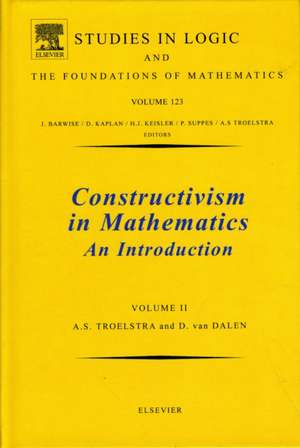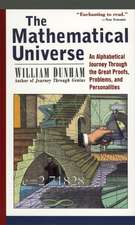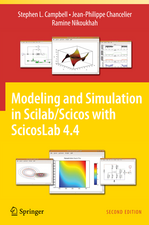Constructivism in Mathematics, Vol 2: Studies in Logic and the Foundations of Mathematics, cartea 123
Autor A.S. Troelstra, D. van Dalenen Limba Engleză Hardback – noi 1988
The publication first takes a look at the topology of metric spaces, algebra, and finite-type arithmetic and theories of operators. Discussions focus on intuitionistic finite-type arithmetic, theories of operators and classes, rings and modules, linear algebra, polynomial rings, fields and local rings, complete separable metric spaces, and located sets. The text then examines proof theory of intuitionistic logic, theory of types and constructive set theory, and choice sequences.
The book elaborates on semantical completeness, sheaves, sites, and higher-order logic, and applications of sheaf models. Topics include a derived rule of local continuity, axiom of countable choice, forcing over sites, sheaf models for higher-order logic, and complete Heyting algebras.
The publication is a valuable reference for mathematicians and researchers interested in mathematics and logic.
Din seria Studies in Logic and the Foundations of Mathematics
- 15%
 Preț: 328.09 lei
Preț: 328.09 lei - 23%
 Preț: 521.67 lei
Preț: 521.67 lei -
 Preț: 396.72 lei
Preț: 396.72 lei - 78%
 Preț: 296.05 lei
Preț: 296.05 lei - 23%
 Preț: 563.29 lei
Preț: 563.29 lei - 20%
 Preț: 794.22 lei
Preț: 794.22 lei - 27%
 Preț: 945.54 lei
Preț: 945.54 lei - 27%
 Preț: 1016.48 lei
Preț: 1016.48 lei - 46%
 Preț: 747.62 lei
Preț: 747.62 lei - 20%
 Preț: 1211.66 lei
Preț: 1211.66 lei - 31%
 Preț: 590.36 lei
Preț: 590.36 lei - 27%
 Preț: 868.94 lei
Preț: 868.94 lei - 27%
 Preț: 741.59 lei
Preț: 741.59 lei - 20%
 Preț: 639.95 lei
Preț: 639.95 lei - 27%
 Preț: 849.60 lei
Preț: 849.60 lei - 20%
 Preț: 1126.74 lei
Preț: 1126.74 lei - 23%
 Preț: 734.18 lei
Preț: 734.18 lei - 27%
 Preț: 1390.23 lei
Preț: 1390.23 lei - 27%
 Preț: 787.87 lei
Preț: 787.87 lei - 39%
 Preț: 771.37 lei
Preț: 771.37 lei - 23%
 Preț: 1014.52 lei
Preț: 1014.52 lei - 27%
 Preț: 783.34 lei
Preț: 783.34 lei
Preț: 343.74 lei
Nou
Puncte Express: 516
Preț estimativ în valută:
65.78€ • 68.42$ • 54.31£
65.78€ • 68.42$ • 54.31£
Carte tipărită la comandă
Livrare economică 08-22 aprilie
Preluare comenzi: 021 569.72.76
Specificații
ISBN-13: 9780444703583
ISBN-10: 0444703586
Pagini: 140
Dimensiuni: 156 x 234 x 41 mm
Greutate: 1.19 kg
Editura: ELSEVIER SCIENCE
Seria Studies in Logic and the Foundations of Mathematics
Locul publicării:Netherlands
ISBN-10: 0444703586
Pagini: 140
Dimensiuni: 156 x 234 x 41 mm
Greutate: 1.19 kg
Editura: ELSEVIER SCIENCE
Seria Studies in Logic and the Foundations of Mathematics
Locul publicării:Netherlands
Public țintă
Students and researchers in Logic (Mathematics, Computer Science, Philosophy).Cuprins
Constructivism in Mathematics: Contents Preliminaries
7. The Topology of Metric Spaces
1. Basic Definitions
2. Complete, Separable Metric Spaces
3. Located Sets
4. Complete, Totally Bounded Spaces
5. Locally Compact Spaces
6. Notes
Exercises
8. Algebra
1. Identity, Apartness and Order
2. Groups
3. Rings and Modules
4. Linear Algebra
5. Polynomial Rings
6. Fields and Local Rings
7. The Fundamental Theorem of Algebra
8. Notes
Exercises
9. Finite-Type Arithmetic and Theories of Operators
1. Intuitionistic Finite-Type Arithmetic
2. Normalization, and a Term Model For HAω
3. The Theory APP
4. Models for APP
5. Abstract Realizability in APP
6. Extensionality and Choice in APP and HAω
7. Some Metamathematical Applications
8. Theories of Operators and Classes
9. Notes
Exercises
10. Proof Theory of Intuitionistic Logic
1. Preliminaries
2. Normalization
3. The Structure of Normal Derivations of N-IQCE
4. The Decidability of IPC
5. Other Applications of Normalization
6. Conservative Addition of Predicative Classes
7. Sequent Calculi
8. N-IQC as a Calculus of Terms
9. Notes
Exercises
11. The Theory of Types and Constructive Set Theory
1. Towards a Theory of Types
2. The Theory MLi0
3. Some Alternative Formulations of MLi0
4. The Types Nk and Reformulation of the E-Rules
5. The Theory ML0
6. Embeddings into APP
7. Extensions of MLi0 and ML0
8. Constructive Set Theory
9. Notes
Exercises
12. Choice Sequences
1. Introduction
2. Lawless Sequences
3. The Elimination Translation for the Theory LS
4. Other Notions of Choice Sequence
5. Notes
Exercises
13. Semantical Completeness
1. Beth Models
2. Completeness for Intuitionistic Validity
3. Incompleteness Results
4. Lattices, Heyting Algebras and Complete Heyting Algebras
5. Algebraic Semantics for IPC
6. Ω-Sets and Structures
7. Validity as Forcing
8. Postscript on Realizability
9. Notes
Exercises
14. Sheaves, Sites and Higher-Order Logic
1. Presheaves, Sheaves and Sheaf-Completion
2. Ω-Presheaf and Ω-Sheaf Structures
3. Some Notions from Category Theory
4. Forcing Over Sites
5. Sheaf Models for Higher-Order Logic
6. Notes
Exercises
15. Applications of Sheaf Models
1. Interpretation of N, Q, Z, R,N in Sh(O(T))
2. The Axiom of Countable Choice
3. Topologies in Sheaves Over a cHa
4. A Derived Rule of Local Continuity
5. The Monoid Model for CS
6. A Site Model for LS
7. Notes
Exercises
16. Epilogue
1. The Role of Language and "Informal Rigour"
2. Intuitionistic Logic, Formalisms, and Equality
3. Brouwer's Theory of the Creative Subject
4. Dummett's Anti-Realist Argument
Bibliography
Index
Index of Names
List of Symbols











